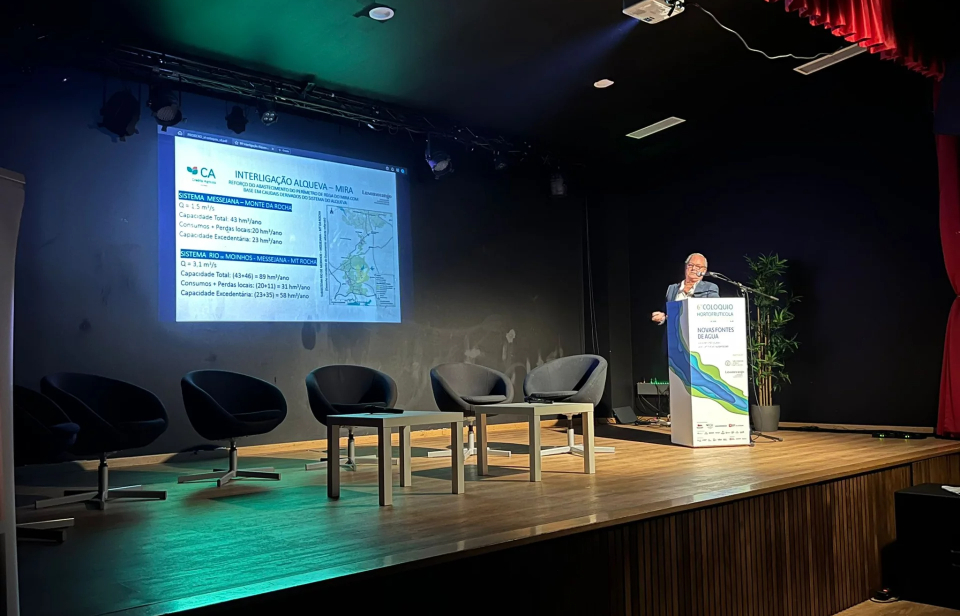A study commissioned by Lusomorango has revealed that connecting Alqueva to the Santa Clara dam, via Monte da Rocha, is not only “technically” but also “economically viable”. The investment would require between €19 million and €42 million depending on the scenarios.
The construction of a transmission line that would allow the transfer of water from Alqueva to the Santa Clara dam, via Monte da Rocha, could cost between 19 million euros and 42 million euros, depending on the solution adopted, according to a study carried out for Lusomorango by Jorge Frois, an agricultural engineer and hydraulics specialist.
“The obvious solution is to use the Alqueva system, which already supplies the neighbouring irrigation areas, Alto Sado, whose Monte da Rocha dam, which will soon receive water from Alqueva, is located about 18 km from the Santa Clara dam reservoir.” According to the study, transferring flows between them “is technically and economically feasible, as long as the current system linked to the Monte da Rocha dam allows it.”
The connection will be a new source of water essential for agricultural activity in the southwest Alentejo, and will be more capable as the water system in the Mira irrigation perimeter becomes more efficient.
The study was presented in São Teotónio, Municipality of Odemira, under the title “Alquiva-Mira Interconnection: Enhancing the supply to the Mira irrigation perimeter based on flows derived from the Alquiva system”. Horticultural Seminarpromoted by Lusomorango – the Small Fruit Producers Organization, in partnership with the Catholic University.
He is considering two solutions. The first involves the transfer of 23 cubic hectares per year to irrigate 8,650 hectares at a cost of 19 million euros, which translates into a unit cost, including investment, maintenance and energy, of 0.061 euros/m3 transported. The second project, on the other hand, involves the transfer of 32 cubic hectares per year to irrigate 12,000 hectares at a total cost of 42 million euros, i.e. a unit value of 0.071 euros/m3 of water transported.
According to the study, despite having sufficient lifting and conveying capacity, Alqueva is “within its water supply capacity” of 620 cubic hectares per year guaranteed by the concession in question, so this issue must be duly considered, in an integrated logic of water supply to all areas adjacent to Alqueva “already provided by EDIA – Alqueva Development and Infrastructure Company.
Since the Mira irrigation perimeter has no alternative “economically acceptable supply,” this “should include, whenever necessary, the apportionment of available water,” the study says, highlighting that EDIA already foresees this solution in its 2023 drought contingency plan.
The Losomorango study is based on a scenario of water scarcity in the region and the need to find other sources to cover “current and future deficits”. In total, water consumption for irrigation and other uses, urban, industrial and touristic, and losses from the system, amount to about 50 cubic hectares per year, only half of which is covered by inflows. The rest comes from “historical” water in the Santa Clara reservoir, which “may only last another 5 or 6 years”.
According to the study, the rehabilitation and modernization of the irrigation system planned for the coming years will allow “significantly reducing the large losses in the system, and improving the efficiency of batch irrigation systems”, but will not be sufficient to “cover the lost quantities in the medium term”, especially under the drought scenario that will continue, according to all known models, due to climate change.
The study “Alqueva–Mira Interconnection: Enhancing the Supply of Mira’s Irrigation Perimeters Based on Flows Derived from the Alqueva System” was presented at the conference 6th Fruit and Vegetable Symposiuman initiative of Lusomorango in partnership with Católica which has JE as Media PartnerAt the forum, companies and local authorities advocated for new water sources in Odemira.
Several officials in S. Teotónio have stated that there is no single, perfect solution to the water shortage in Odemira, there are many. The Secretary of State for Agriculture, João Moura, considered that: “Without water, there is no agriculture, and a country without agriculture is guaranteed to be weaker”. Professor Ricardo Reis, from the Catholic University, stated that the migration policy cannot be solved in S. Teotónio.
A study entitled “Atlantic Waters of the Southwest Alentejo” explores the implementation of a desalination plant as one of the solutions to the problem of water scarcity that tends to worsen with climate change.

“Wannabe internet buff. Future teen idol. Hardcore zombie guru. Gamer. Avid creator. Entrepreneur. Bacon ninja.”

